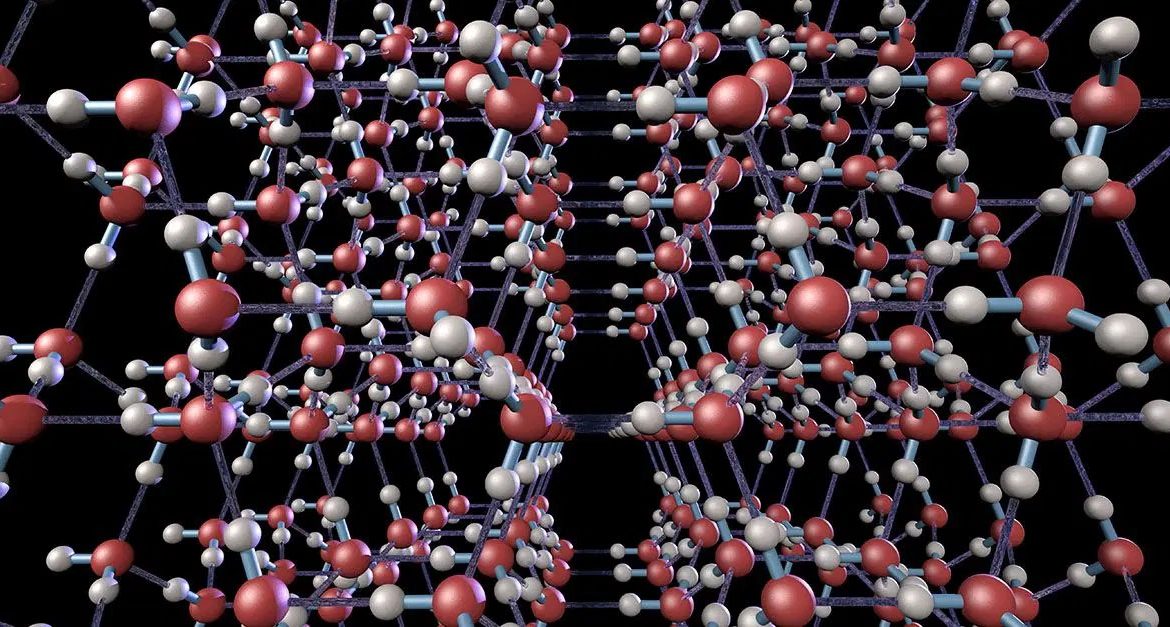| Jun 17, 2022 |
|
(Nanowerk News) Hydrogen bonds are of fundamental interest in materials science, physics and chemistry. An international team including scientists from the University of Bayreuth has now achieved surprising insights into the formation of hydrogen bonds using a novel method that enables the application of NMR spectroscopy in high-pressure research.
|
|
The research results, published in Nature Communications (“Structural independence of hydrogen-bond symmetrisation dynamics at extreme pressure conditions”), may be a starting point for the targeted design of materials that contain symmetrical hydrogen bonds and therefore exhibit extraordinary, potentially technologically interesting properties.
|
 |
| Ball-and-stick model of water molecules locked into a hexagonal structure by hydrogen bonds when water freezes into ice.
|
|
In nature, hydrogen bonds, a weak form of chemical bonding, are very common. They have a stabilizing effect on larger molecular systems, for example, on the structure of DNA as the carrier of genetic material. Hydrogen bonds exist whenever a hydrogen atom mediates an interaction between two molecules or two sections of a very large molecule.
|
|
The electrostatic charges of the hydrogen atom and the two atoms that form the opposing “bridgeheads” are crucial in this process. Of great scientific interest are structures in which the hydrogen atom lies midway between these atoms. Such symmetric hydrogen bridges are often accompanied by extraordinary physical properties such as superconductivity or superionicity.
|
|
Until now, research had not yet reached a deeper understanding of the causes and modes of operation of hydrogen bonds and their symmetrization. However, a close collaboration between researchers from the University of Bayreuth, Linköping University and the Center for High Pressure Science & Technology Advanced Research in Beijing has now achieved a decisive advance: For the first time, a method developed at the Bavarian Research Institute of Experimental Geochemistry and Geophysics (BGI) of the University of Bayreuth, which exposes material samples in diamond anvil cells to extremely high pressures and simultaneously makes them accessible to NMR spectroscopic investigation, has been applied to the analysis of hydrogen bonds.
|
|
Thus, in the BGI laboratories, hydrogen bonds could be detected with previously unattained precision in very different materials: in ice phases VII and X, in phase D magnesium silicate, and in ferrous and non-ferrous aluminum oxyhydride compounds. In all cases, oxygen atoms formed the bridgeheads.
|
|
In particular, the new method made it possible to identify the spatial position of the hydrogen atoms and to clarify the conditions under which symmetrization of the hydrogen bonds occurs.
|
|
The results surprised the researchers: although the chemical constituents and structures of the materials studied are very different, the behaviour of hydrogen bonds between oxygen atoms is very similar. The researchers found that under compression symmetrization occurs at a particular oxygen-oxygen distance. It is at precisely this distance that the pressure causes the hydrogen atom to be located midway between the oxygen atoms.
|
|
Moreover, the NMR data demonstrated that the hydrogen bond symmetrization is not a trigger of electron spin transitions – contrary to what has been sometimes assumed in research.
|
|
“Symmetric hydrogen bonds have been shown in our study to be a physical phenomenon in their own right. They form independently of the chemical and quantum mechanical properties of their environment and are also independent of structural features of their surroundings,” summarizes Dr. Thomas Meier, lead author of the new study.
|
|
At the BGI of the University of Bayreuth, he developed the new method in collaboration with Prof. Leonid Dubrovinsky and his team for applying NMR spectroscopy in high-pressure and high-temperature research. Since 2022, Dr. Meier has been working at the Center for High Pressure Science & Technology Advanced Research in Beijing.
|
|
“Now we know considerably more about the physical mechanisms underlying the symmetrization of hydrogen bonds. Applications of NMR spectroscopy in high-pressure research allow new insights into unique regularities in the nature of materials,” says Prof. Leonid Dubrovinsky from the BGI.
|


